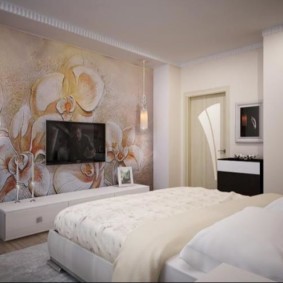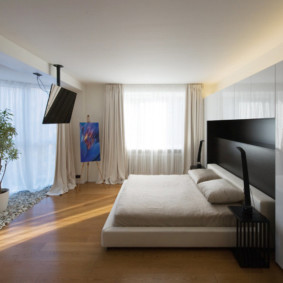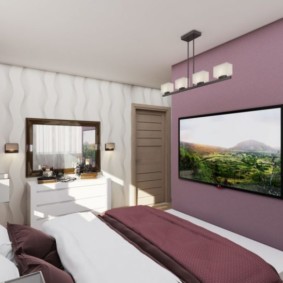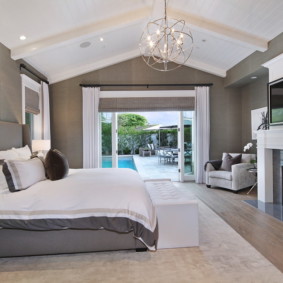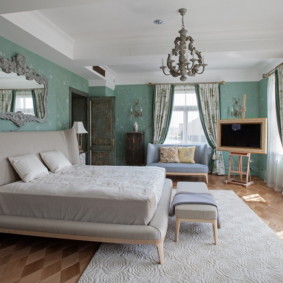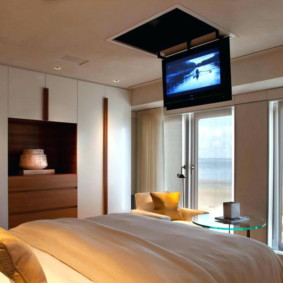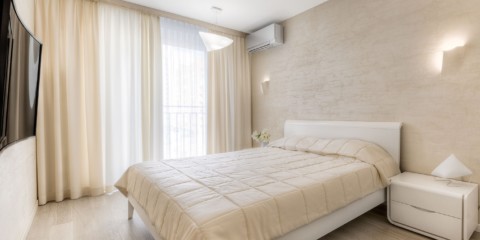 Bedroom
Neoclassical bedroom
Bedroom
Neoclassical bedroom
When buying a new TV, first of all, you need to sensibly evaluate the dimensions of the room, and how exactly this diagonal will fit into its size. Too large a screen can quickly damage your eyesight when you watch TV in a small bedroom. Therefore, do not blindly follow the fashion for large diagonals. A powerful TV audio system can also negatively impact people in a small room. It is also advisable to determine the place where the TV will be placed even before the purchase. And already on this basis, focus on the size of the screen, its concavity or convexity, and other characteristics.

The TV can become a real decoration of the interior of the bedroom
It is necessary to take into account the design of the equipment - how much it will harmonize with the interior of the room. For example, if the bedroom is decorated in warm golden tones, the steel-colored television panel will be out of place.
The nuances of fixing the TV to the wall
Content
- The nuances of fixing the TV to the wall
- Installing a TV in different rooms
- Choose a height for the location of the TV in the room
- General recommendations
- Features of mounting the TV on the wall
- Options for a beautiful TV on the wall
- Video on how to hang a TV on a do-it-yourself bracket
- Photo: TV in the bedroom interior
Typically, television monitors are mounted on the wall using brackets. Installation on the pedestal has a number of disadvantages - the screen is easy to break with careless movement. If the house has small children, the risk of damaging the monitor becomes even greater. And the pedestal requires additional space to be allocated for it. Therefore, the bracket is the most ergonomic and convenient option.

TV wall mount eliminates bulky furniture
There are several types of brackets:
- Fixed or fixed. This is a plate with mounts for TV.
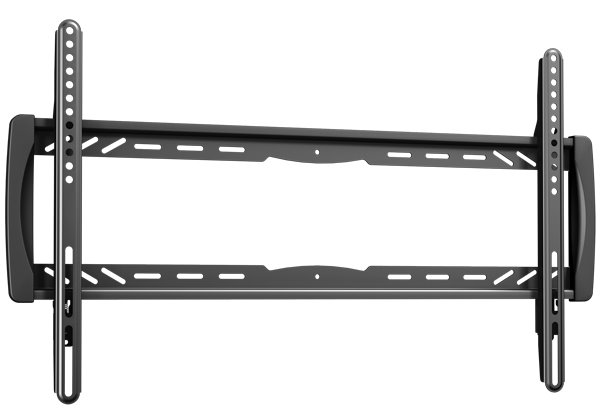
The advantage of a fixed bracket is low cost
- Swivel - such a suspension makes it possible to choose a viewing angle, and adjust it both in the vertical and horizontal plane.

The swivel-tilt bracket is more expensive, but it provides an adjustment of the position of the TV in two planes
- Inclined - provides an angle of inclination of the screen up to 20 degrees. Unlike the swivel, the adjustment is carried out only in the vertical plane.
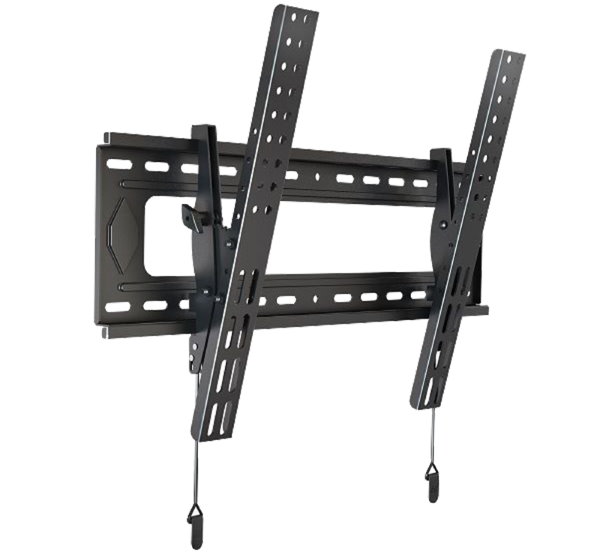
Inclined bracket with spring tilt adjustment mechanism
- Retractable - with the help of a special leg on hinges, you can adjust the distance to the screen.
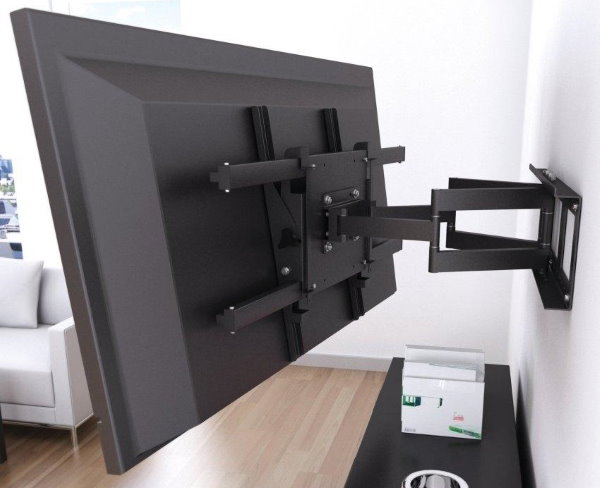
Retractable bracket provides maximum convenience in adjusting the position of the television panel
- Ceiling - the best choice for large rooms with high ceilings. The telescopic leg makes it possible to adjust the distance to the viewer. If the walls are sheathed with drywall, it is also worth stopping on the ceiling mount.
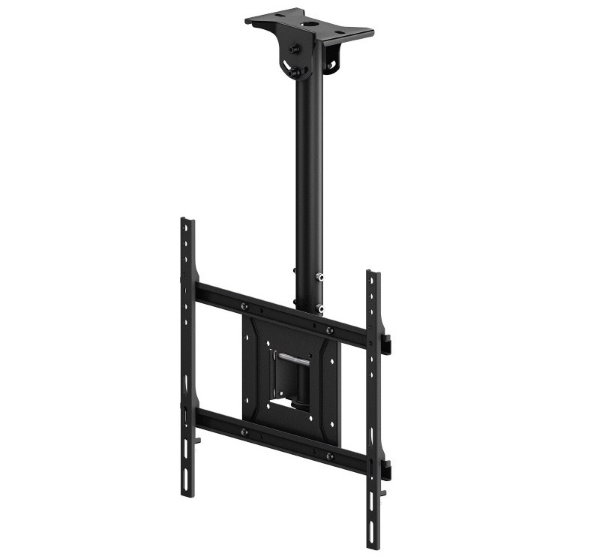
Adjustable boom ceiling mount
There are also combined mounting options. These are pan-tilt and tilt-and-slide brackets. But in everyday life they are used less often, since their installation is quite complicated.
When choosing a mount, consider the following:
- TV dimensions (diagonal, width, weight). If the TV is too wide, then its edges will abut against the wall, and not allow to freely adjust the position. And if it weighs more than 20 kg, then it is better to start the installation together.
- The standard and location of the mounting holes on the back of the TV. It is under them that the holder for the TV is selected.
- Desired height and viewing angle, the need to adjust them.
- The material of which the walls are made - whether they will support the weight of the monitor along with the mount.
The bracket cannot be fixed to a wall sheathed with drywall, and even more so to a false wall made of this material. The dowels can go into the empty space between the wall and the plaster, or simply not get to the supporting wall. In this case, the wall simply can not withstand the weight of the mount and the TV, and the whole structure will fall. Also, during installation, you need to know exactly where the hidden wiring passes, so as not to accidentally get into it.
Installing a TV in different rooms

Convenient functional designs help to seamlessly fit the TV into the interior of the room
Bedroom
The height at which the TV is hung on the wall in the bedroom depends on the location of the bed. It is from there that it is worth starting the placement of the screen. It is recommended that you lie down on your bed in your usual position, and present the direction of your gaze into the intended screen. Approximately in the center of this imaginary monitor, you should place the TV in the bedroom. If there is a shallow niche opposite the berth, it will be wise to place it in it.

The height of the TV in the bedroom depends on the height of the bed
For the bedroom, it is undesirable to choose to choose a too “loud” television set with a powerful audio system. This is primarily a lounge, and the low-frequency sound of the built-in subwoofer does not contribute to relaxation before bedtime.
In this room, the TV will look good on a pedestal, selected in color and in accordance with the style of the bedroom set.

It will be convenient to store disks, magazines and accessories for a multimedia system in the cabinet under the TV
Kitchen
For the kitchen, TVs with a small screen diagonal are usually chosen. This is not the main viewing place, but rather a way to have fun while cooking, or to find out the latest news at breakfast. Therefore, it is important that the monitor is compact, and does not interfere with the location of other household appliances and kitchen cabinets.

The place for the TV in the kitchen is selected away from the sink and stove
Living room
This is a gathering place for the whole family and receiving guests. In the living room decided to place the "main" TV-receiver. As a rule, they are the most overall in comparison with TVs in other rooms. In the living room, it is worthwhile to carefully choose the design of the TV and how to fix it.

Harmoniously looks TV, placed between shelves with books or decorations
If it is obvious that the television panel does not look inappropriate, then a good way to disguise it is a niche with wings that can be closed if desired. For the classic style, there is another option - to frame the screen. Such a "picture" will not spoil the interior, but rather, harmoniously fit into it.
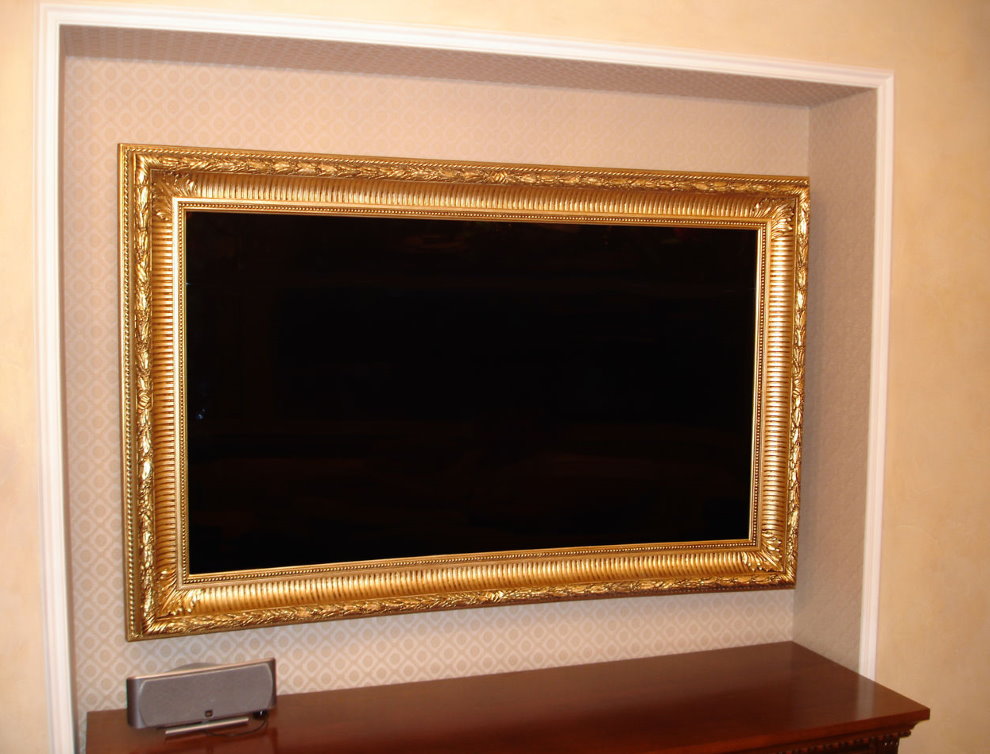
Gold-framed TV - the perfect solution for a classic interior
Children
A TV in a children's room is an ambiguous solution. After all, uncontrolled watching TV has a harmful effect on the eyesight of children. But if you decide to install it there, then you should make sure that the fragile monitor is out of the reach of the child. Brackets can help with this. But you don’t need to install too high either - in this case it will be hard to look at the screen. It is best to choose the location of the TV according to the height of the child - for this you can squat or bend over and imagine a screen.

The TV in the children's room must be firmly fixed, for example, you can use a table mount with additional fixing screws to the furniture surface
Now it’s not uncommon that televisions are in several rooms at once. A reasonable decision is to buy TV sets from one company. The TV remote is easy to lose, and if you have interchangeable remotes, this will not be a problem.
Choose a height for the location of the TV in the room
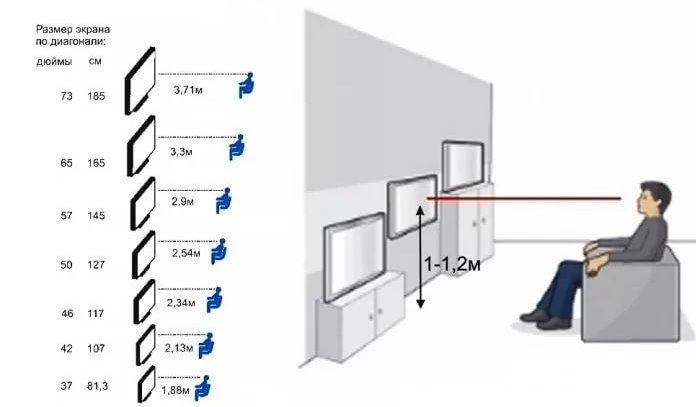
The minimum recommended distance to the TV, depending on the diagonal of the screen
Optimal distance
When watching TV, it is important that the vision does not suffer. Therefore, ophthalmologists recommend choosing a distance to the TV of at least one and a half meters. Too close a screen adversely affects the optic nerves.

The distance to the TV directly depends on the diagonal of the screen
For LCD monitors, the distance from the viewer should correspond to the diagonal of the screen times two or three. For example, if a TV with a diagonal of 32 inches, then, multiplying, you get 64 or 96 inches. We translate inches to centimeters, and we get a distance range of 162-264 cm. It is this arrangement of the TV panel that will be optimal in this case. A huge panel of 64 inches should be placed at almost five meters from the audience. Therefore, when buying a TV, you need to consider whether you have such a distance.
Calculation of the correct position
To calculate the optimal position of the television panel, you should sit in your usual position and mentally imagine the screen on the wall. In the direction of the eye, in the center of an imaginary monitor, and should be placed TV.

The correct location of the TV on the bedroom wall depends on the position in which the person is used to looking at the screen
Recommended height from floor level
In order not to harm your eyesight, the height of the TV from the floor in the living room and other rooms should not exceed 120-130 cm. However, if it is impossible to install it at that height, you can choose a place a little higher from the floor level.

In a general-purpose room, the height of the TV suspension is calculated based on the sitting position of a person
The main thing is to focus on comfort for all family members. The height at which the TV in the bedroom should be hung depends on the level and location of the bed.
General recommendations
- It is not recommended to install a TV above the door, since the height of the standard door exceeds the range of the safe viewing angle. It is especially not worth doing this in the bedroom, where TV is watched mainly from the bed, in the supine position. The height and viewing angle of the TV on the wall in the bedroom and other rooms should be comfortable and convenient for all family members.
- Opposite the window, the TV also should not be placed. Sunlight will interfere with viewing. If the choice of places for location is limited, then during the day you can use blackout curtains with the effect of blackout.
- The TV panel should be placed at a small distance from the wall, but in no case not close to it. There should also be adequate ventilation in the room. Otherwise, the TV may quickly overheat, because the air will not pass through its ventilation channels.

In a small bedroom, a compact TV model will be appropriate
Features of mounting the TV on the wall
In order for wires and sockets not to spoil the design of the room, you need to consider their location. It is best to use brackets with an already provided space in order to hide the wires from the plug. If the TV is on a pedestal or in a niche - the wires should be located at the back.

Concealed wiring - a popular solution to the problem of masking wires behind a TV
In the case of cable TV, the wires can be hidden in the cable channel. Now there are a huge number of types of cable boxes in various designs. Therefore, you can choose the one that will not cut your eyes in the interior of the room.

Cables, cords and other accessories can be hidden in the cabinet on which the TV is located
Outlets are also placed behind the TV panel so that they are not striking. It’s worth using a unit from several outlets to connect a set-top box for digital TV, a Wi-Fi adapter or an additional audio system if necessary.
The cable leading from the TV to the power outlet must be in the free position.If the power cord is too tight, even spontaneous combustion can occur.
Options for a beautiful TV on the wall
A wall with a TV can be used as a color accent in the room. To do this, the wall is decorated in brighter colors than the rest of the room. For example, if the room is decorated in sand, then for the wall with the TV you can apply a warm terracotta color. For light pink walls, the space around the screen can be accented with shades of purple or raspberry. Other bright decor elements will also look good - a clock, a photo frame in a gamut similar to the frame of the screen.

A TV built into furniture is an interesting solution, especially if the screen merges with the facade

The TV panel elegantly looks among photos in thin frames
In addition, the following options will effectively look:
- Imitation of a picture frame around the screen. To do this, you can use panels with decorative trim - imitation of gilding, or ornament. In order to make the TV look more harmonious, you can hang real pictures or photos in the same frame nearby.
- The TV is in a niche. You can create a niche using drywall or natural wood panels. A niche with a mirror or glossy finish is well suited for a small room, visually increasing it. It’s best to leave some space around the TV - this will help ensure proper ventilation.
- Screen over the electric fireplace. The decision is ambiguous, because, despite the spectacular appearance, the TV will be located above the recommended level (the distance from the fireplace should be at least a meter). But you can get out of the situation by dividing the living room into relaxation areas in front of the fireplace, and watching TV.
- TV panel on a shelf or on a pedestal. Any horizontal surface, including suspension structures, can be used to position the TV. The main thing is to evaluate its weight so that the regiment can withstand. The frame around the screen looks beautiful if it harmonizes with the color of the furniture, or, on the contrary, stands out in contrast (if the general idea of the interior allows vivid contrasts). The screen looks spectacular in a black frame on a snow-white stand against a wall with a black and white decor.
- Backlit wall. This option does not give glare on the screen, as from overhead lighting or sunlight. On the contrary, LED backlighting further emphasizes the area with the TV and looks aesthetically pleasing. Looks good in the niche with a TV.

Laconic plasma panel favorably emphasizes a strict minimalist interior

You can hide the TV behind the cabinet doors if you don’t want to ruin the style of the room
Thus, there are a huge number of options for beautifully designed TV in the room. By correctly applying them, and placing the TV panel at a comfortable distance for yourself, you can create a harmonious part of the interior. And with proper design, the TV can even become one of the accent points of the design of the room.
Video on how to hang a TV on a do-it-yourself bracket





